
The Dolomites, also known as the Dolomite Mountains, Dolomite Alps or Dolomitic Alps, are a mountain range in northeastern Italy. They form part of the Southern Limestone Alps and extend from the River Adige in the west to the Piave Valley in the east. The northern and southern borders are defined by the Puster Valley and the Sugana Valley. The Dolomites are in the regions of Veneto, Trentino-Alto Adige/Südtirol and Friuli Venezia Giulia, covering an area shared between the provinces of Belluno, Vicenza, Verona, Trentino, South Tyrol, Udine and Pordenone.
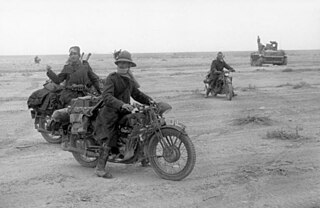
The 1st Army was a Royal Italian Army field army, in World War I, facing Austro-Hungarian and German forces, and in World War II, fighting on the North African front.

The Battle of Vittorio Veneto was fought from 24 October to 3 November 1918 near Vittorio Veneto on the Italian Front during World War I. After having thoroughly defeated Austro-Hungarian troops during the defensive Battle of the Piave River, the Italian army launched a great counter-offensive: the Italian victory marked the end of the war on the Italian Front, secured the dissolution of the Austro-Hungarian Empire and contributed to the end of the First World War just one week later. On 1 November, the new Hungarian government of Count Mihály Károlyi decided to recall all of the troops, who were conscripted from the territory of Kingdom of Hungary, which was a major blow for the Habsburg's armies. The battle led to the capture of over 5,000 artillery pieces and over 350,000 Austro-Hungarian troops, including 120,000 Germans, 83,000 Czechs and Slovaks, 60,000 South Slavs, 40,000 Poles, several tens of thousands of Romanians and Ukrainians, and 7,000 Austro-Hungarian loyalist Italians and Friulians.

Valli del Pasubio is a town in the province of Vicenza, Veneto, Italy. It is north of SP46.

The Tre Cime di Lavaredo, also called the Drei Zinnen ; pronounced[ˌdʁaɪˈtsɪnən] ), are three distinctive battlement-like peaks, in the Sexten Dolomites of northeastern Italy. They are probably one of the best-known mountain groups in the Alps. The three peaks, from east to west, are:

Cristallo is a mountain massif in the Italian Dolomites, northeast of Cortina d'Ampezzo, in the province of Belluno, Veneto, northern Italy. It is a long, indented ridge with four summits higher than 3,000 metres. The mountain range is part of the Ampezzo Dolomites Natural Park.
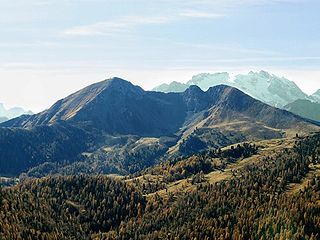
The Col di Lana is a mountain of the Fanes Group in the Italian Dolomites. The actual peak is called Cima Lana and situated in the municipality of Livinallongo del Col di Lana in the Province of Belluno, Veneto region.

Monte Priaforà is a mountain of the Veneto, Italy. It has an elevation of 1,659 metres. It is part of the Little Dolomites with Cima Palon.

The Vicentine Alps are a mountain range of the Eastern Alps in Trentino and the provinces of Verona and Vicenza. The mountains were named after the city of Vicenza which lies at their eastern edge. The highest point in the range is the Cima Dodici on the northern perimeter of the Vicentine Alps.
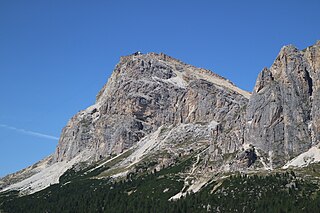
Lagazuoi is a mountain in the Dolomites of northern Italy, lying at an elevation of 2,835 metres (9,301 ft), about 18 kilometres (11 mi) southwest by road from Cortina d'Ampezzo in the Veneto Region. The mountain is part of the Ampezzo Dolomites Natural Park.
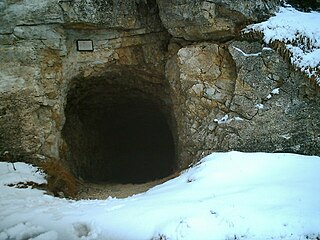
The mines on the Italian front during the First World War comprised a series of underground explosive charges of varying sizes, secretly planted between 1916 and 1918 by Austro-Hungarian and Italian tunneling units beneath their enemy's lines along the Italian front in the Dolomite section of the Alps.
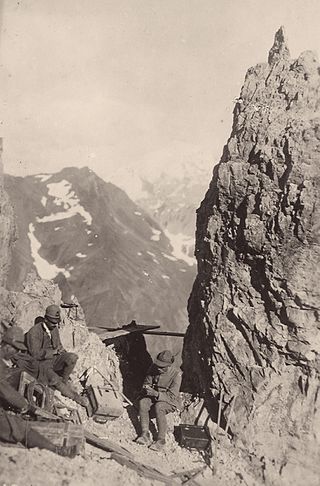
The Alpini are a specialised mountain warfare infantry corps of the Italian Army, which distinguished itself in World War I fighting in the Alps against Austro-Hungarian Kaiserjäger and the German Alpenkorps. The Alpini were supported by the Mountain Artillery, which both share the Cappello Alpino as identifying symbol. Below follow tables listing the regiments, battalions and groups, companies and batteries of the Alpini and Mountain Artillery active in World War I.

The 62nd Infantry Regiment "Sicilia" is an active unit of the Italian Army based in Catania in Sicily. The regiment is part of the Italian army's infantry corps and operationally assigned to the Mechanized Brigade "Aosta".

The 85th Volunteer Training Regiment "Verona" is an active unit of the Italian Army based in Verona in Veneto. The regiment is named for the city of Verona and was part of the Italian Army's infantry arm until it became a training unit and was redesignated as a "multi-arms unit".
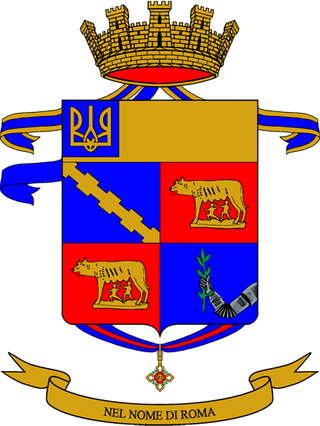
The 80th Regiment "Roma" is an active unit of the Italian Army based in Monte Romano in Lazio. The regiment is named for the city of Rome and was part of the Italian Army's infantry arm until 2004, when it became a training unit and was redesignated as a "multi-arms unit" and designated 80th Volunteer Training Regiment "Roma". In December 2023 the regiment became a training support unit at the Monte Romano training range with the new name 80th Regiment "Roma".

The White War is the name given to the fighting in the high-altitude Alpine sector of the Italian front during the First World War, principally in the Dolomites, the Ortles-Cevedale Alps and the Adamello-Presanella Alps. More than two-thirds of this conflict zone lies at an altitude above 2,000m, rising to 3905m at Mount Ortler. In 1917 New York World correspondent E. Alexander Powell wrote: “On no front, not on the sun-scorched plains of Mesopotamia, nor in the frozen Mazurian marshes, nor in the blood-soaked mud of Flanders, does the fighting man lead so arduous an existence as up here on the roof of the world.”

Roberto Olmi was an Italian general during World War II.

Monte San Michele (Italian) or Debela griža (Slovene) is a hill on the Karst Plateau, in the Italian province of Gorizia, on the border between the municipalities of Sagrado and Savogna d'Isonzo. It is located eight kilometres southwest of Gorizia, on the left bank of the Isonzo, and has four peaks, the highest two of which have an elevation of 275 meters above sea level, while the lowest has an elevation of 237 meters, and Cima Quattro stands at 264 meters.

Dente Italiano is one of the ridges of the Pasubio summit highlands in the Vicentine Alps.
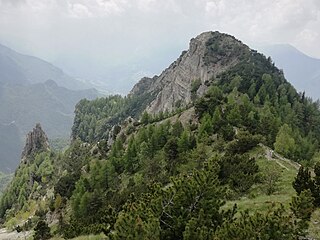
Monte Corno Battisti, previously known as Monte Corno or Corno di Vallarsa, is a mountain of Trentino, Italy, with an elevation of 1,778 metres (5,833 ft). It is part of the Pasubio massif in the Vicentine Alps, in the Province of Trento.






















